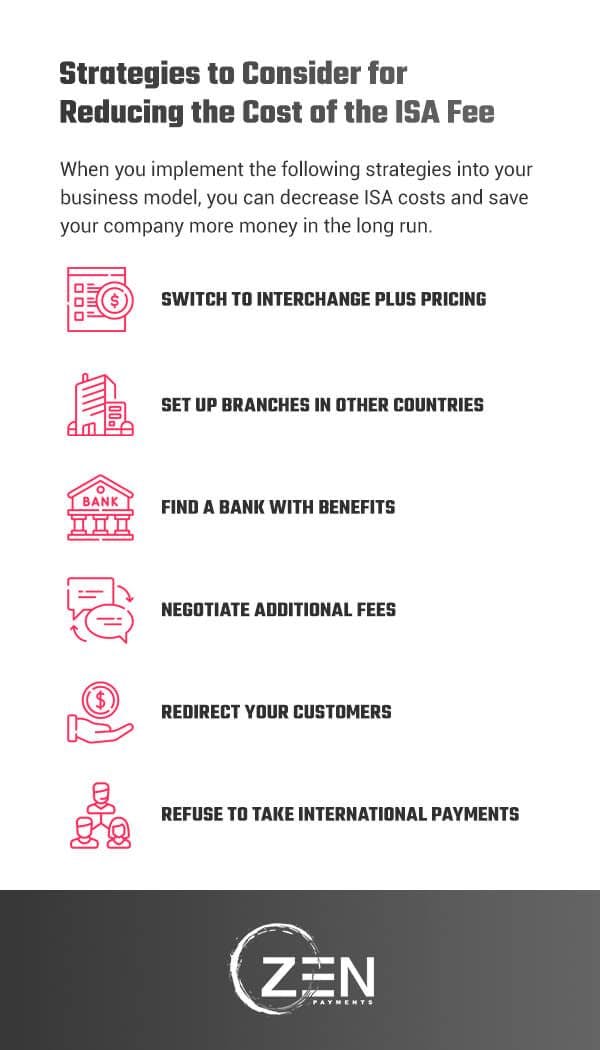Finding an unexpected charge on your monthly bill is something no merchant wants to see. If you discover that your processing statement is much higher than usual but don’t know why, you may have been charged with an international service assessment (ISA) fee. Though you probably didn’t go on an overseas spending spree yourself, one of your customers likely did. That said, why should these charges fall on you?
As a business owner, you must understand the implications behind ISA fees and how they occur, as these costs can add up. Though ISA debit card fees can be complex and inconvenient for business owners, you can minimize these charges to help you save money in the long run. Through this article, you’ll learn about international assessment fees, how they work, what they cost and strategies for potentially reducing them for your business.
What Are International Service Assessment Fees?
ISA fees are processing fees that Visa charges to merchants when customers use their bank-issued credit or debit cards outside of the United States. While interchange rates occur on international transactions, ISA fees are additional charges placed on top of those rates.
Visa and other credit card companies, such as Discover, MasterCard and American Express, implement this fee for international purchase transactions with or without currency conversion requirements. When a merchant receives an ISA fee, it goes into their monthly domestic transactions statement, which they’ll view and pay for monthly.
When Are International Assessment Fees Charged?
ISA fees are dictated by the acquiring bank with which the merchant account is associated and the issuing bank on the customer’s side. If a customer makes a transaction within the U.S. and uses a card issued by a bank based or registered in a different country, the merchant will receive an ISA fee. Even if the issuing bank has a U.S. branch, the charges will still apply.
Additionally, businesses may receive an international processing fee for e-commerce purchases, even if the shopper uses an out-of-country card to ship a product to an address within the United States. A common instance where merchants are issued Visa international service assessment fees is when a tourist from another country makes a transaction at a U.S. business using a credit or debit card from their country. Here, the merchant is charged a convenience fee for the transaction.
How Much Is the International Assessment Fee?
The percentage of ISA fees varies by bank. Though there are set percentages for international assessment fees, these charges differ based on the currency of the transaction. Visa’s international service assessment fees fall at 0.8% for all transactions made with a card issued outside of the U.S., with a conversion rate of 1.20%.
For example, when a customer makes a purchase using U.S. dollars, their fee will only be 0.8% of the transaction. If they transact using foreign currency, Visa will implement an additional 0.4% to convert it to American currency. Additionally, ISA rates increase annually due to the growing number of foreign transaction fees.

Who Pays the International Service Assessment Fee?
Though it may seem most logical for the customer to pay the international assessment fee since they made the foreign exchange transaction, that’s not the case. Visa has no way of billing the cardholder for their charges directly, so the international processing fee goes to the merchant.
Usually, the fee will go to the merchant’s processor, which will then implement the cost into the business’s monthly account statement. However, this course of action depends on their agreement with the processor, including payment setup and contract.
As a merchant, you likely have one of three payment pricing setups — flat, tiered, or interchange plus.
Interchange Plus
Through the interchange plus pricing strategy, the payment processor charges the merchant an interchange fee and a fixed fee or percentage based on the specific transaction, including the card and how the customer ran it. In other words, the processor margin takes on a set percentage across transactions while the interchange fee fluctuates depending on the type of transaction being processed. These two elements ultimately dictate the final cost the merchant must pay.
This payment approach is considered the most granular of the three and has an element of transparency that merchants tend to prefer.
Tiered
This type of pricing has a diverse array of cost structures, making it the least transparent of the three pricing setups. However, it’s among the most common pricing methods in the U.S.
This payment approach is dependent on the type of card the customer uses for their international transaction — whether a credit card, debit card or prepaid card — and includes various charges that may or may not appear on your monthly statement. The tiered pricing model also considers how you accepted the card. For example, it may consider whether the card was swiped or keyed in.
Through the tiered payment setup, the processor takes different interchange fees and categorizes them into three groups based on the risks associated with each specific transaction. The tiers are organized as follows:
- Qualified rate: This tier’s transactions must meet all of the processor’s processing requirements. These types of exchanges carry the lowest risks and have the lowest rates.
- Mid-qualified rate: The mid-qualified rate applies to transactions that don’t meet all payment processor specifications. For example, a keyed-in transaction where the credit card isn’t physically present poses a higher fraud risk, causing businesses to pay a higher fee.
- Non-qualified rate: If a transaction doesn’t meet processor requirements and presents a high risk, it falls into the non-qualified tier and is issued the highest fees. Some examples of common non-qualified transactions include reward card, e-commerce and signature card transactions.
Flat
Finally, flat pricing requires merchants to pay a flat rate fee for all international processing transactions, regardless of factors like card type and brand. This pricing model includes a simple but inflated rate, and processors may bundle it into your plan. Some ISA fees will be listed as such, while others will appear as “miscellaneous fees” or “other fees.”
What's the Difference Between the ISA Fee and the IAF Fee?
Though it’s easy to confuse international service assessment fees and international acquirer fees (IAFs), these international processing charges aren’t the same. In fact, ISA fees and IAFs are two entirely separate Visa fees. However, you’ll always receive both fees at the same time, and you’ll never find one without the other.
Visa charges international acquirer fees under the same premise as ISA fees — the main difference is primarily a matter of semantics across cardmember associations. Unlike ISA fees, IAFs are fixed at 0.45% or 0.9% for high-risk Merchant Category Codes (MCCs). Similarly, processors charge merchants the IAF because they can’t bill customers directly.
An IAF won’t always appear on your monthly statement as its own line item, as processors have control over what information you can see. That’s usually the case for merchants with flat-rate pricing models or whose processors group multiple fees together. However, if you’re on a tiered or interchange plus pricing plan and accept a Visa payment issued outside of the U.S., you’re more likely to see one or both of the international assessments on your bill.
The IAF will appear by name or a name variation in the Visa charges section of your statement, along with the rate charged and the transaction amount to which the fee applied.

Strategies to Consider for Reducing the Cost of the ISA Fee
Unfortunately, ISA debit card fees are unavoidable for merchants who participate in cross-border sales, whether in-store or online. That’s because international transactions require more effort and resources to process than local purchases and pose even higher risks for credit card networks. Like insurance premiums, these fees are inevitable. However, there are various ways you can potentially minimize your international service assessment costs as a business owner.
Successfully reducing ISA fees for your organization is certainly worth a try if it means saving you money. When you implement the following strategies into your business model, you can decrease ISA costs and save your company more money in the long run. However, be sure to weigh the pros and cons of each tactic to make the most informed decision for your business.
1. Switch to Interchange Plus Pricing
Among the three payment pricing setups for Visa international service assessment fees, the interchange plus model is typically the most beneficial for merchants whose customers make foreign transactions. Through this pricing agreement, you’ll be able to evaluate each international transaction individually and pay minimum rates for each of them.
Furthermore, interchange plus pricing is highly transparent and makes it easy to ensure you’re getting the best deal on your payment processing. Because card brands commonly set interchange fees, you can use this setup to compare rates between different processors, helping you choose one with the most affordable rates.
2. Set Up Branches in Other Countries
If your company gets a substantial portion of its business from a foreign country, creating a new business branch in that particular location may benefit you. Once your register your organization in that country, you can apply for a merchant account, which will allow you to accept locally issued credit cards. While this option won’t eliminate cross-border charges altogether, it may help you reduce ISA fees and extra processing fees.
3. Find a Bank With Benefits
It’s a good idea to use a bank that makes international processing easier and less expensive. For example, you may want to go through an acquiring bank that supports multi-currency processing. This cross-border payment processing solution enables businesses to accept credit cards from customers using foreign currencies, potentially saving them thousands in international processing costs.
Be sure to weigh your options and keep an eye out for banks that offer processing perks.
4. Negotiate Additional Fees
It’s essential to keep an eye on your processing fees for international transactions. Though your processor doesn’t profit from the credit card company’s base fees, they can gain by charging your business additional amounts.
If you find that your processor is issuing extra fees for international service assessments and other cross-border fees, you may be able to negotiate them. Be sure to assess your monthly statements closely, looking for any additional charges with little to no explanation. If these costs seem unwarranted, contact your processor to discover the nature of the fees.
5. Redirect Your Customers
Though this ISA fee reduction method isn’t a clear-cut solution, it’s still one to consider. As a business, you may be able to encourage your customers to purchase your merchandise through local distributors rather than buying the products internationally. For example, you can try implementing incentives for customers who shop through your U.S.-based branches, such as coupons and discount codes.
6. Refuse to Take International Payments
The last thing you can do to avoid ISA fees for your business is to avoid taking international payments altogether. However, it’s important to note that engaging in this method will likely impact your enterprise significantly. Refusing to accept international payments may result in lost sales, costing your business more than you initially spent on ISA debit card fees.
If you consider this option for your business, you should give it considerable thought before following through. Make sure to weigh the advantages and downsides of this specific tactic, especially in regard to your finances.
Reduce Your ISA Debit Card Fees at Zen Payments Today
If you’re looking to minimize your Visa international service assessment fees, the experts at Zen Payments can help. We believe that all businesses should get the financial assistance they need to thrive. That’s why we provide merchant account services to companies of all types — even if they’re considered high-risk.
Our full suite of services spans across industries and includes retail, e-commerce and high-risk processing services for businesses with high refund rates, free trial offers, bad personal credit and other risk factors. When you sign on with Zen Payments, we’ll enable your company to accept all forms of payment, provide you with website integration technologies or help your team manually enter customers’ credit card information.
Contact us to receive an account quote within 24 hours and get started with our merchant services today!





